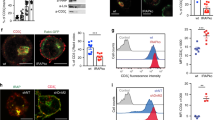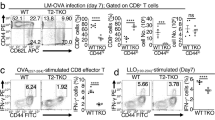Abstract
Productive interaction of a T lymphocyte with an antigen-presenting cell results in the clustering of the T-cell antigen receptor (TCR) and the recruitment of a large signalling complex to the site of cell–cell contact1,2. Subsequent signal transduction resulting in cytokine gene expression requires the activation of one or more of the multiple isoenzymes of serine/threonine-specific protein kinase C (PKC)3. Among the several PKC isoenzymes expressed in T cells, PKC-θ is unique in being rapidly recruited to the site of TCR clustering4. Here we show that PKC-θ is essential for TCR-mediated T-cell activation, but is dispensable during TCR-dependent thymocyte development. TCR-initiated NF-κB activation was absent from PKC-θ-/- mature T lymphocytes, but was intact in thymocytes. Activation of NF-κB by tumour-necrosis factor α and interleukin-1 was unaffected in the mutant mice. Although studies in T-cell lines had suggested that PKC-θ regulates activation of the JNK signalling pathway5,6, induction of JNK was normal in T cells from mutant mice. These results indicate that PKC-θ functions in a unique pathway that links the TCR signalling complex to the activation of NF-κB in mature T lymphocytes.
This is a preview of subscription content, access via your institution
Access options
Subscribe to this journal
Receive 51 print issues and online access
$199.00 per year
only $3.90 per issue
Buy this article
- Purchase on Springer Link
- Instant access to full article PDF
Prices may be subject to local taxes which are calculated during checkout





Similar content being viewed by others

References
Monks, C. R., Freiberg, B. A., Kupfer, H., Sciaky, N. & Kupfer, A. Three-dimensional segregation of supramolecular activation clusters in T cells. Nature 395, 82–86 (1998).
Grakoui, A. et al. The immunological synapse: a molecular machine controlling T cell activation. Science 285, 221–227 (1999).
Valge, V. E., Wong, J. G., Datlof, B. M., Sinskey, A. J. & Rao, A. Protein kinase C is required for responses to T cell receptor ligands but not to interleukin-2 in T cells. Cell 55, 101–112 (1988).
Monks, C. R., Kupfer, H., Tamir, I., Barlow, A. & Kupfer, A. Selective modulation of protein kinase C-θ during T-cell activation. Nature 385, 83–86 (1997).
Werlen, G., Jacinto, E., Xia, Y. & Karin, M. Calcineurin preferentially synergizes with PKC-θ to activate JNK and IL-2 promoter in T lymphocytes. EMBO J. 17, 3101–3111 (1998).
Ghaffari-Tabrizi, N. et al. Protein kinase Cθ, a selective upstream regulator of JNK/SAPK and IL-2 promoter activation in Jurkat T cells. Eur. J. Immunol. 29, 132–142 (1999).
Kisielow, P., Bluthmann, H., Staerz, U. D., Steinmetz, M. & von Boehmer, H. Tolerance in T-cell-receptor transgenic mice involves deletion of nonmature CD4+8+ thymocytes. Nature 333, 742–746 (1988).
Meller, N., Altman, A. & Isakov, N. New perspectives on PKCθ, a member of the novel subfamily of protein kinase C. Stem Cells 16, 178–192 (1998).
Smith, K. A. The interleukin 2 receptor. Annu. Rev. Cell Biol. 5, 397–425 (1989).
Genot, E. M., Parker, P. J. & Cantrell, D. A. Analysis of the role of protein kinase C-α, -ε, and -ζ in T cell activation. J. Biol. Chem. 270, 9833–9839 (1995).
Weiss, A. & Littman, D. R. Signal transduction by lymphocyte antigen receptors. Cell 76, 263–274 (1994).
Weiss, L. et al. Regulation of c-Jun NH(2)-terminal kinase (jnk) gene expression during T cell activation. J. Exp. Med. 191, 139–146 (2000).
Shapiro, V. S., Truitt, K. E., Imboden, J. B. & Weiss, A. CD28 mediates transcriptional upregulation of the interleukin-2 (IL-2) promoter through a composite element containing the CD28RE and NF-IL-2B AP-1 sites. Mol. Cell. Biol. 17, 4051–4058 (1997).
Northrop, J. P. et al. NF-AT components define a family of transcription factors targeted in T-cell activation. Nature 369, 497–502 (1994).
Jain, J., Loh, C. & Rao, A. Transcriptional regulation of the IL-2 gene. Curr. Opin. Immunol. 7, 333–342 (1995).
Jamieson, C., McCaffrey, P. G., Rao, A. & Sen, R. Physiologic activation of T cells via the T cell receptor induces NF-κB. J. Immunol. 147, 416–420 (1991).
Jain, J., Valge-Archer, V. E., Sinskey, A. J. & Rao, A. The AP-1 site at -150 bp, but not the NF-κB site, is likely to represent the major target of protein kinase C in the interleukin 2 promoter. J. Exp. Med. 175, 853–862 (1992).
Sloan-Lancaster, J. & Allen, P. M. Altered peptide ligand-induced partial T cell activation: molecular mechanisms and role in T cell biology. Annu. Rev. Immunol. 14, 1–27 (1996).
Newton, A. C. Regulation of protein kinase C. Curr. Opin. Cell Biol. 9, 161–167 (1997).
Edwards, A. S., Faux, M. C., Scott, J. D. & Newton, A. C. Carboxyl-terminal phosphorylation regulates the function and subcellular localization of protein kinase C βII. J. Biol. Chem. 274, 6461–6468 (1999).
Kong, Y. Y. et al. Vav regulates peptide-specific apoptosis in thymocytes. J. Exp. Med. 188, 2099–2111 (1998).
Fischer, K. D. et al. Vav is a regulator of cytoskeletal reorganization mediated by the T-cell receptor. Curr. Biol. 8, 554–562 (1998).
Holsinger, L. J. et al. Defects in actin-cap formation in Vav-deficient mice implicate an actin requirement for lymphocyte signal transduction. Curr. Biol. 8, 563–572 (1998).
Kawakami, Y. et al. Activation and interaction with protein kinase C of a cytoplasmic tyrosine kinase, Itk/Tsk/Emt, on FcεRI cross-linking on mast cells. J. Immunol. 155, 3556–3562 (1995).
Zandi, E. & Karin, M. Bridging the gap: composition, regulation, and physiological function of the IκB kinase complex. Mol. Cell. Biol. 19, 4547–4551 (1999).
Esslinger, C. W., Jongeneel, C. V. & MacDonald, H. R. Survival-independent function of NF-κB/Rel during late stages of thymocyte differentiation. Mol. Immunol. 35, 847–852 (1998).
Boothby, M. R., Mora, A. L., Scherer, D. C., Brockman, J. A. & Ballard, D. W. Perturbation of the T lymphocyte lineage in transgenic mice expressing a constitutive repressor of nuclear factor (NF)-κB. J. Exp. Med. 185, 1897–1907 (1997).
Hettmann, T., DiDonato, J., Karin, M. & Leiden, J. M. An essential role for nuclear factor κB in promoting double positive thymocyte apoptosis. J. Exp. Med. 189, 145–158 (1999).
Acknowledgements
We thank S. Marmon for preparing fusion proteins used to generate antisera; M. Brown for analysis of the antisera; B. Alfonso and W. O'Brien for genotyping; D. Alpert, M. Rincon and R. Davis for advice on the JNK assays; and E. Skolnik, A. Zychlinsky, Y. Zou and D. Unutmaz for their critical reading of the manuscript. C.W.A. is supported by a fellowship award from the Medical Research Council of Canada. Z.S. is supported by an NIH Molecular Oncology and Immunology training grant. E.M.S. is a Howard Hughes Medical Institute–NIH Research Scholar. P.L.S. is supported in part by a Searle Scholar award, and A.K is supported by a grant from the NIH. W.E. is an Associate and D.R.L. is an Investigator of the Howard Hughes Medical Institute.
Author information
Authors and Affiliations
Corresponding author
Rights and permissions
About this article
Cite this article
Sun, Z., Arendt, C., Ellmeier, W. et al. PKC-θ is required for TCR-induced NF-κB activation in mature but not immature T lymphocytes. Nature 404, 402–407 (2000). https://doi.org/10.1038/35006090
Received:
Accepted:
Issue Date:
DOI: https://doi.org/10.1038/35006090
This article is cited by
-
HIV-1-induced nuclear invaginations mediated by VAP-A, ORP3, and Rab7 complex explain infection of activated T cells
Nature Communications (2023)
-
Addressing the role of PKD3 in the T cell compartment with knockout mice
Cell Communication and Signaling (2022)
-
Anti-inflammatory effects of anemonin on acute ulcerative colitis via targeted regulation of protein kinase C-θ
Chinese Medicine (2022)
-
Functional implications of the CpG island methylation in the pathogenesis of celiac disease
Molecular Biology Reports (2022)
-
Eucalyptus essential oils inhibit the lipopolysaccharide-induced inflammatory response in RAW264.7 macrophages through reducing MAPK and NF-κB pathways
BMC Complementary Medicine and Therapies (2020)
Comments
By submitting a comment you agree to abide by our Terms and Community Guidelines. If you find something abusive or that does not comply with our terms or guidelines please flag it as inappropriate.


